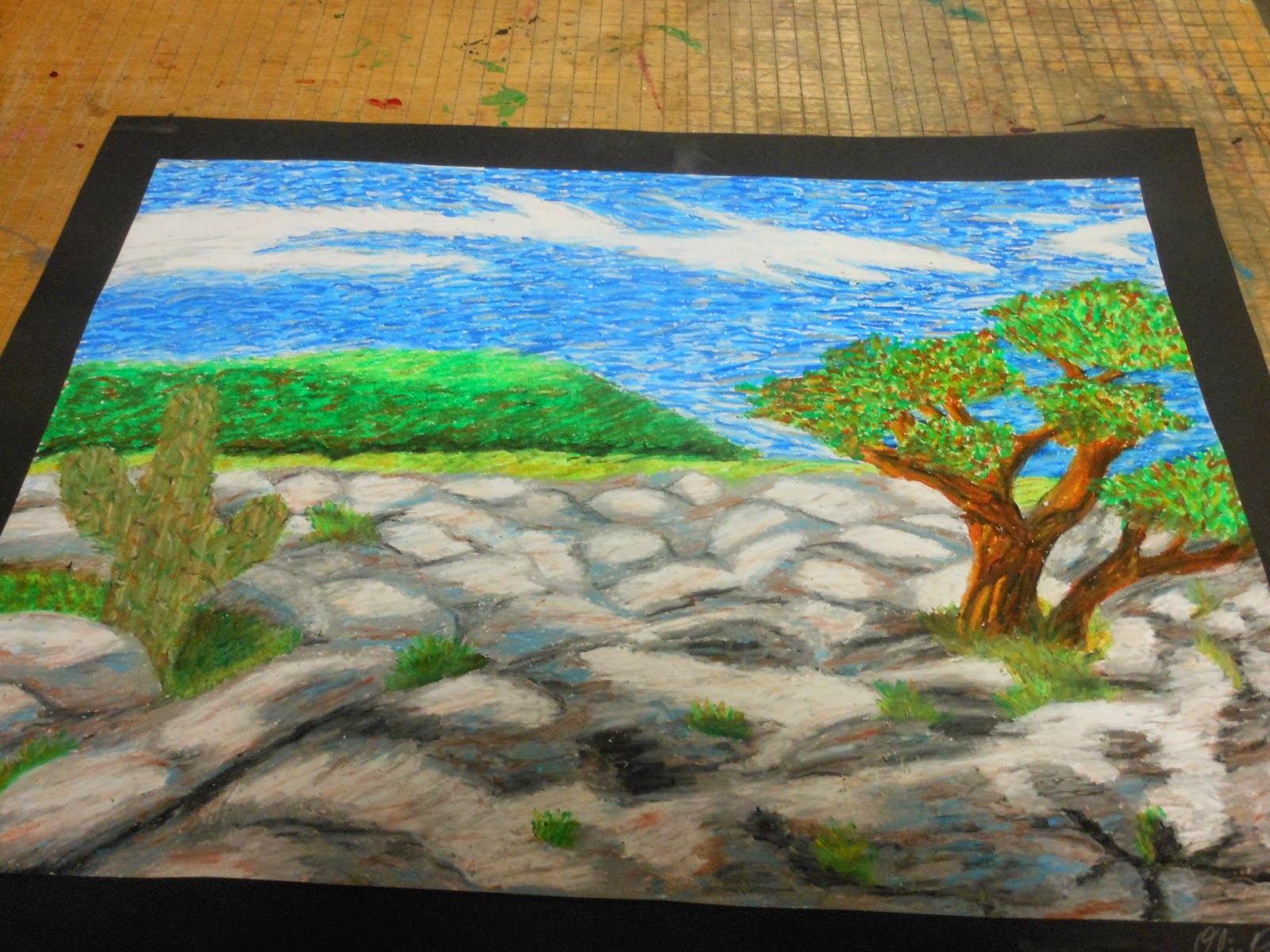WHAT TO DO! (And I learned the FUN way)
1.) TRUST!
- There's a reason I put this one first! As middle school teachers I feel we spend WAY too much time worrying about what our student MIGHT do. "I can't give them this material" "They won't be able to do that". No way! This personal style of teaching comes actually from the way I was raised. My mom is well... THE BEST! Growing up she always trusted my brothers and I. Yes, even as teenagers. She trusted us to choose the right option and to not let her down. Did we always do it? No, but the fear of losing mom's trust was WAY worse then missing out on things that were stupid anyways. I apply the same principle in my classroom. I trust my students! I tell them that and they know that trust means fun materials and a relaxed classroom environment. When trust is lost and I need to start "babysitting" my 12-14 year old, they work really hard to win that trust back. Don't waste paint and clean-up properly? We get to do fun painting project! Throwing paint and hiding dirty palettes? (yes, it's happened) We get to spend 10 min of class checking out every materials and 10 min checking them back in.
- Oh goodness that sounds strict and yes the kids don't 100% love it, but it is incredibly important! As artist we know that groove we get in when we really sink into our artwork. We get lost in the process and before we know it hours have gone by. WE get it! Students need to feel it! I explain to my students that this 5 minutes of voices off will allow them to get into that groove. When the minutes are up, I find that typically students stay on task and get less distracted by their peers.
- Every class I have my students come-in (with a greeting from me), get their portfolios and general supplies. EVERYTHING goes under their desk when that first bell rings. This way their hand are empty and their ears are more focused. With large projects, I literally have the students put their hands in the air like they're getting arrested hehe. Once students are settled I go over announcement, reminders, do understanding check-in, show them new materials, etc. My personal favorite is "Rebel Buck Quizzes". Appleton is on the PBIS system my school has little dollars that we hand out to students for awesome behaviors. It's like a fun mini-quiz! Kiddos love it.
- Middle school is a cluster of change. Students are going through puberty which makes them hypersensitive to change, so throwing a big change at them will make them lock-up. Small changes they don't see or notice though? Works for everyone. For example, my #1 goal is to create independent artists. Not because I just want to sit on my butt and not teach, but because independence forces students to figure it out themselves. PROBLEM SOLVE! (I sang that out loud by the way). Now if I did one project where I gave all the answers students wanted and then the next project I answered none, students would quit! Instead I slow roll it from 6th grade to 8th grade. By the time my students reach 8th grade they barely need me which leaves me available to create WITH my students. AMAZING! (yes singing again)
- Okay so this is a little contradictory to my "Do Trust" mantra but let's face it middle schoolers are spacey! Clean-up is hectic and having things numbered allows me to simply say "who's got Xacto 4". It's better than walking out of class with a weapon, that's for sure. The labeling aspect is my solution to the "did you really ask thats". "Mrs. Koepke? Where's the thumbnail paper?" Instead of wanting to yell "THE SAME PLACE IT'S ALWAYS BEEN!" I get to point or send students on a treasure hunt!
6.) Use of Stop Clock
- I don't know how I survived without this! Last year was a constant struggle to get class started or get students back after collaborative work...but now! I project this stop watch and like magic my voice is saved! Here's the one I use http://www.online-stopwatch.com/
7.) Tell Your Students Why, Right Away
- Expecting students to just MAKE the connections between projects and the world is just not going to happen. Connections didn't start clicking for me until college. "Oh yeah! I understand that Freshmen Year lesson now". Why leave it such a mystery? Avoid the "why do we have to learn this?" tendency by well...TELLING THEM right off the bat. I always have a slide, discussion, etc. with my students about how this new lesson connects with our previous lesson, how this lesson will benefit them as artists and people and how each lesson connects with the bigger picture! Yes! Every lesson. Even one dayers. If you link this one with #4 before you know it you'll just ask "why does this matter" and the students will answer. It rocks!
8.) Keep Content Challenging!
9.) Let Your Students Give-up (but not for long)
- Okay, honesty time. Sometimes I'm browsing Pinterest and come across a middle school art project that like, "Ummm...I think you meant appropriate for Pre-K". Challenging students at any age level is incredibly important. How will students grow if we do the color wheel in Elementary, Middle and High school? The one thing I will brag about is my ability to PUSH my students. I never underestimate my students and I don't let them underestimate themselves. Giving-up is okay for five minutes but then right back at it!
- Yes I said it! Let your student give up. Seriously. Frustration is one of the most natural responses to the creative process and frustration+middle school= WAHHHHH!!!!!. I teach my students how to realize when they are getting frustrated with their work and how to give up...but not for long. When I'm doing my own artwork, I will get literally angry sometimes. If I said someone over my shoulder telling me, "well this is art time and we do art now" I'd go crazy too. Soon after however I come back revisit the piece with a clear mind and fresh eyes. Students will do the same.
- So part of our job is to get these kiddos the information about materials, art history, process, etc. but there will ALWAYS be kids that just aren't having it. Disrespect, swearing, talking back, misusing materials (like REALLY misusing) is going to happen. ESPECIALLY in middle school. It might be one project or all the projects, but having back-up options for off taskers is just as important as back-up options for early finishers. When a student of mine just isn't listening to any form of reason I can offer, back-up task is my final offer. Unfortunately it sometimes has to be done to maintain a healthy learning environment for ALL students. My favorites are apology letter, think tank write-up and in extreme cases alternative projects where students research and reflect about the concepts we are working on. I know that can sound harsh or like I'm making reading and writing a punishment, but I want the students to get the information one way or another. If they can't do the hands-on route then they'll do the studying route.
11.) Let Your Students Help you Lesson Plan
- Nobody knows what makes sense to middle schooler better than a middle schooler. Some of you may have read my "Understanding Armatures" post, where I described how I gave the students the option of how to best execute the project. I just could figure out which way would best serve my students, so I asked them. I showed them what I thought were two ways to achieve the similar results and then we discussed which made sense. In this discussion I got confused, they got confused, I made suggestions and they made suggestions. By the end of the discussion, WE had creatively solved how to best do this project. Now don't get me wrong, I came with the goods. I explained all the things mentioned in #7 and definitely had the background knowledge to keep the discussion moving in a constructive way, but theres a reason why those projects turned out so awesome...they students got invested in their learning. Shhh....don't tell them.
12.) I'm just going to smoosh a bunch of random Dos here....
- Keep making art!
- Make make art with your students! Right next to em'! Don't worry, everything won't fall apart
- Be silly with your kids
- Be yourself
- Get to know your students
- Give your students space
- Sleep
- Eat
- and Laugh...oh goodness, please laugh :)



















































